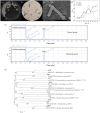Determining the Benzo[a]pyrene Degradation, Tolerance, and Adsorption Mechanisms of Kefir-Derived Bacterium Bacillus mojavensis TC-5
- PMID: 40807664
- PMCID: PMC12346863
- DOI: 10.3390/foods14152727
Determining the Benzo[a]pyrene Degradation, Tolerance, and Adsorption Mechanisms of Kefir-Derived Bacterium Bacillus mojavensis TC-5
Abstract
Microbial detoxification, as an environmentally friendly strategy, has been widely applied for benzo[a]pyrene (BaP) degradation. Within this approach, food-derived microbial strains offer unique advantages in safety, specificity, and sustainability for detoxifying food-borne BaP. In this study, we aimed to explore the potential of such strains in BaP degradation. Bacillus mojavensis TC-5, a strain that degrades BaP, was isolated from kefir grains. Surprisingly, 12 genes encoding dehydrogenases, synthases, and oxygenases, including betB, fabHB, qdoI, cdoA, and bioI, which are related to BaP degradation, were up-regulated by 2.01-fold to 4.52-fold in TC-5. Two potential degradation pathways were deduced. In pathway I, dioxygenase, betaine aldehyde dehydrogenase, and beta-ketoacyl-ACP synthase III FabHB act sequentially on BaP to form 4H-pyran-4-one,2,3-dihydro-3,5-dihydroxy-6-methyl via the phthalic acid pathway. In the presence of the cytochrome P450 enzyme, BaP progressively mediates ring cleavage via the anthracene pathway, eventually forming 3-methyl-5-propylnonane in pathway II. Notably, TC-5 achieved an impressive BaP removal efficiency of up to 63.94%, with a degradation efficiency of 32.89%. These results suggest that TC-5 has significant potential for application in addressing food-borne BaP contamination. Moreover, our findings expand the application possibilities of Xinjiang fermented milk products and add to the available green strategies for BaP degradation in food systems.
Keywords: Bacillus mojavensis; benzo[a]pyrene; degradation pathway; kefir.
Conflict of interest statement
The authors declare no conflicts of interest.
Figures





Similar articles
-
Prescription of Controlled Substances: Benefits and Risks.2025 Jul 6. In: StatPearls [Internet]. Treasure Island (FL): StatPearls Publishing; 2025 Jan–. 2025 Jul 6. In: StatPearls [Internet]. Treasure Island (FL): StatPearls Publishing; 2025 Jan–. PMID: 30726003 Free Books & Documents.
-
Role and mechanism of benzo[a]pyrene in the transformation of chronic obstructive pulmonary disease into lung adenocarcinoma.J Cancer Res Clin Oncol. 2023 Jul;149(8):4741-4760. doi: 10.1007/s00432-022-04353-y. Epub 2022 Oct 13. J Cancer Res Clin Oncol. 2023. PMID: 36229541 Free PMC article.
-
The Black Book of Psychotropic Dosing and Monitoring.Psychopharmacol Bull. 2024 Jul 8;54(3):8-59. Psychopharmacol Bull. 2024. PMID: 38993656 Free PMC article. Review.
-
Predicting the developmental toxicity of 8-methyl-benzo[a]pyrene (BaP) by physiologically based kinetic (PBK) modeling-facilitated reverse dosimetry and read-across from BaP.Arch Toxicol. 2025 Jul 3. doi: 10.1007/s00204-025-04115-y. Online ahead of print. Arch Toxicol. 2025. PMID: 40610614
-
Signs and symptoms to determine if a patient presenting in primary care or hospital outpatient settings has COVID-19.Cochrane Database Syst Rev. 2022 May 20;5(5):CD013665. doi: 10.1002/14651858.CD013665.pub3. Cochrane Database Syst Rev. 2022. PMID: 35593186 Free PMC article.
References
-
- Cheng J.L., Zhang X.H., Ma Y., Zhao J., Tang Z.W. Concentrations and distributions of polycyclic aromatic hydrocarbon in vegetables and animal-based foods before and after grilling: Implication for human exposure. Sci. Total Environ. 2019;690:965–972. doi: 10.1016/j.scitotenv.2019.07.074. - DOI - PubMed
-
- Sun Y.Q., Yan K., Wu S.M., Gong G.Y. Occurrence, spatial distribution and impact factors of 16 polycyclic aromatic hydrocarbons in milks from nine countries. Food Control. 2020;113:107197. doi: 10.1016/j.foodcont.2020.107197. - DOI
-
- Saravanakumar K., Sivasantosh S., Sathiyaseelan A., Sankaranarayanan A., Naveen K.V., Zhang X., Jamla M., Vijayasarathy S., Priya V.V., MubarakAli D., et al. Impact of benzo[a]pyrene with other pollutants induce the molecular alternation in the biological system: Existence, detection, and remediation methods. Environ. Pollut. 2022;304:119207. doi: 10.1016/j.envpol.2022.119207. - DOI - PubMed
Grants and funding
LinkOut - more resources
Full Text Sources

